人教版初中英语教案—八年级下册第一单元
- 格式:doc
- 大小:159.13 KB
- 文档页数:24
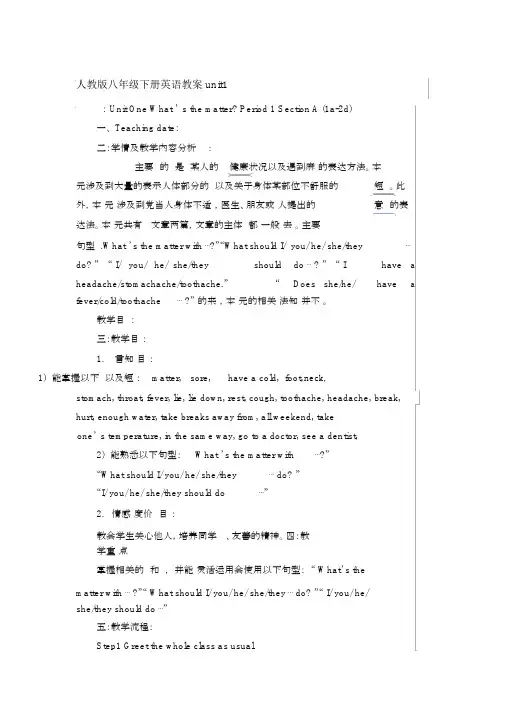
人教版八年级下册英语教案unit1: Unit One What ’ s the matter? Period 1 Section A (1a-2d)一、 Teaching date:二:学情及教学内容分析:主要的是某人的健康状况以及遇到麻的表达方法。
本元涉及到大量的表示人体部分的以及关于身体某部位不舒服的短。
此外,本元涉及到党当人身体不适,医生、朋友或人提出的意的表达法。
本元共有文章两篇,文章的主体都一般去。
主要句型 .What ’s the matter with ⋯?”“What should I/ you/ he/ she/they⋯do? ” “ I/ you/ he/ she/they should do ⋯ ? ” “ I have aheadache/stomachache/toothache.”“Does she/he/have afever/cold/toothache⋯ ?” 的来,本元的相关法知并不。
教学目 :三:教学目:1.言知目:1) 能掌握以下以及短:matter, sore, have a cold, foot,n eck,stomach, throat, fever, lie, lie down, rest, cough, toothache, headache, break,hurt, enough water, take breaks away from, all weekend, takeone’ s temperature, in the same way, go to a doctor, see a dentist,2) 能熟悉以下句型:What ’s the matter with⋯?”“What should I/ you/ he/ she/they⋯do?”“I/ you/ he/ she/they should do⋯”2.情感度价目:教会学生关心他人,培养同学、友善的精神。
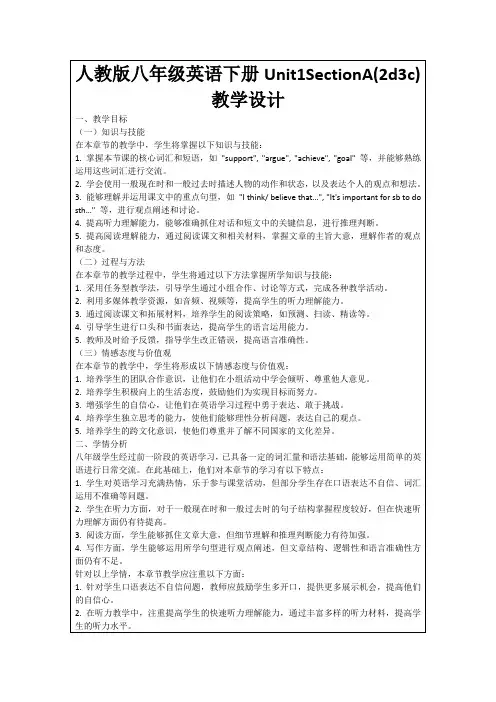
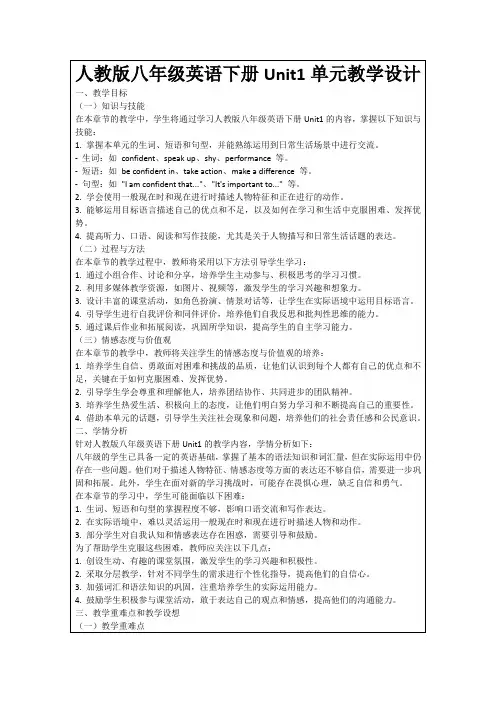
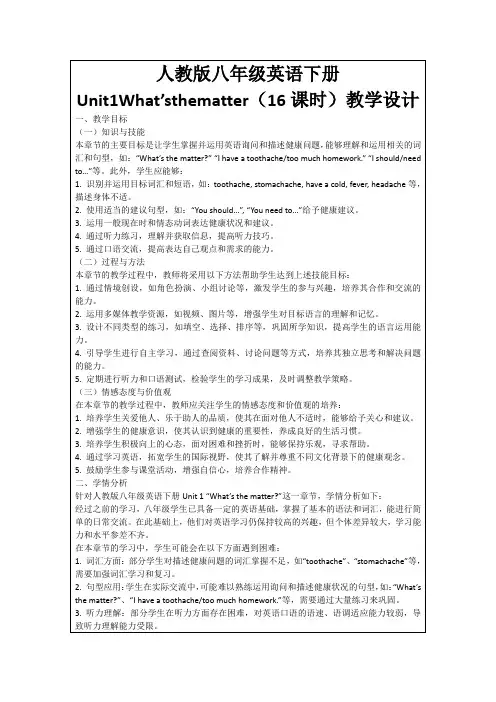

人教版八年级英语下册-Unit1-教案教学目标- 学生能够掌握并正确运用本单元的词汇和短语。
- 学生能够熟练运用本单元所学的句型进行口语表达。
- 学生能够通过阅读和听力理解本单元的相关话题。
- 学生能够参与到小组讨论和角色扮演的活动中,进一步提高口语交流能力。
教学内容一、词汇本单元重点词汇和短语包括:environmental, influence, pollution, reduce, recycle, waste, energy, natural resources, electric, appliance等。
二、语法本单元主要研究以下句型:1. It's important to + 动词。
例如:It's important to protect the environment.2. What should/could we do to + 动词?例如:What should we do to reduce pollution?三、听说读写通过听力活动和阅读材料,让学生了解有关环境保护的知识,并提高他们的听说读写能力。
四、口语交流组织小组讨论和角色扮演的活动,让学生通过对话的方式进行口语练,提高他们的口语交流能力。
五、拓展活动邀请环保专家或相关领域的人士来学校进行讲座,让学生进一步了解环保知识,并激发他们保护环境的意识和行动。
教学步骤第一课时1. 导入新课,介绍本单元的话题。
2. 学生听音,跟读词汇和短语。
3. 听力练,让学生根据听到的对话内容选择正确的图片。
4. 提出问题,让学生讨论并说出不同的解决办法。
第二课时1. 复上节课的内容,让学生回顾所学的词汇和句型。
2. 阅读活动,让学生阅读课文,并回答相关问题。
3. 角色扮演,让学生根据课文中的对话内容进行角色扮演。
第三课时1. 复上节课的内容,进行口头测试,检查学生对所学内容的掌握情况。
2. 小组讨论,让学生分组讨论如何保护环境,并给出建议。
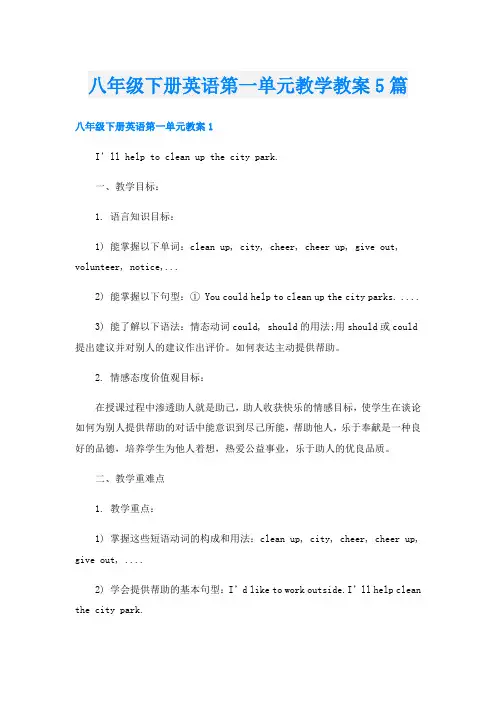
八年级下册英语第一单元教学教案5篇八年级下册英语第一单元教案1I’ll help to clean up the city park.一、教学目标:1. 语言知识目标:1) 能掌握以下单词:clean up, city, cheer, cheer up, give out, volunteer, notice,...2) 能掌握以下句型:① You could help to clean up the city parks. ....3) 能了解以下语法:情态动词could, should的用法;用should或could 提出建议并对别人的建议作出评价。
如何表达主动提供帮助。
2. 情感态度价值观目标:在授课过程中渗透助人就是助己,助人收获快乐的情感目标,使学生在谈论如何为别人提供帮助的对话中能意识到尽己所能,帮助他人,乐于奉献是一种良好的品德,培养学生为他人着想,热爱公益事业,乐于助人的优良品质。
二、教学重难点1. 教学重点:1) 掌握这些短语动词的构成和用法:clean up, city, cheer, cheer up, give out, ....2) 学会提供帮助的基本句型:I’d like to work outside.I’ll help clean the city park.2. 教学难点:学会提供帮助的基本句型三、教学过程Period 1(Section A 1a-2d)Step 1 Warming up1. 播放学生志愿者进行义务帮助别人的活动视频,通过询问他们以下问题来引导学生们了解社会上一些的志愿们进行的活动。
Step 2 New words Read new words on p9-10.Step 3 Discussion1. 1a. Look at the ways you could help others. Then list other ways.2. Ss discuss with their partners and write the ways one could help others:① Help plant trees by the river. ② Help clean up the city park.③ Visit the old people in the old people’s home. ④ Help young kids to learn English.Step 4 Listening1. T: Tell Ss to read the sentences in the chart. Make sure they know the meaning of the sentences.2. 1b. Play the recording for the Ss to listen and number the ways the boy and girl could help others.Step 5 Pair work1. Let Ss read the conversation in the picture.2. 1c. Use the information in the chart of 1b to make other conversations.A: I hope to work outside.B: You could help to clean up the city parks. ........3. Let some pairs act out their conversations.Step 6 Listening1. 2a:T: A group of students are planning a City Park Clean-up Day. Listen and check (√) the things they are going to do to tell people about it.1. Look at the pictures in 2a. Discuss the things they are going to do.2. Play the recording for the Ss to listen and check the pictures.3. Play the recording again to check the answers.2. 2b:1. Let Ss read the sentences below. Explain some main sentences for the Ss. Make sure they know what to do.2. Play the recording for the Ss to write the correct words in the blanks.3. Play the recording again to check the answers.Step 7 Pair work1. 2c. Tell Ss to make a conversation using the information in 2a and 2b.2. Let one pair to read out thei r conversation first.e.g. A: We need to come up with a plan for the City Park Clean-Up Day.B: Let’s have lunch first.A: No, we need to start now. Clean-Up Day is only two weeks from now.B: You’re right. We can’t put off making a plan. As we talk, I’ll write down all our ideas. Then we can decide which ideas are best.A: Let’s make some notices, too. Then I’ll hand them out after school.B: And we could each call up ten students and ask them to come.3. Ss act the conversation in pairs. Ask some pairs to act out their con versations.Step 8 Reading and Role-play1. Read the conversations and answer the two questions:① Where’s Helen going to work this summer?__________________________________② What did Tom do to help the old people?____________________________________Answers: She’s going to work in an old people’s home.Reading the newspaper or just talking to the old people.2. Read the conversation after the teacher.3. Practice the conversation with their partner. Then let some pairs to act out the conversation.Homework:Teaching thought:Period 2(Section A 3a-3c)Step 1 Revision1. Write down the phrases.1. 打扫 ________2. 分发 ________3. 曾经 _______4. (使)变得高兴 ________5. 义务做某事 _________________6. 大打扫日 ______________7. 想出主意(办法)____________2. Role-playA: Hi, Tom. I’m making some plans to work in an old people’s home this summer.B: Really? I did that last summer!Step 2 New words Read new words on p11.Step 3 Reading1.Tell Ss to read the article in 3a quickly and try to find the answers to these questions:1. What does Mario love?2. What does Mary love?3. What do Mario and Mary volunteer to do?Ss read the article quickly and try to answer the questions:Answers: 1. He loves animals.2. She loves reading books.3. Mario volunteers at animal hospital and Mary helps kids learn to read.2.3b: Read the article again and answer the questions.1. Why does Mario volunteer to help others?2. Why does Mary volunteer to help others?3. What does Mario say about volunteering?4. What does Mary say about volunteering?Answers: 1. Because he believes it can help him to get his future dream job.2. Because she can do what she loves to do and help others.3. He gets such a strong feeling of satisfaction when he sees the animals get better and the look of joy on their owners’ face.4. Volunteering is a dream come true for her.Homework Make sentences with these words.help (to) do; want to do; learn to do; decide to do; how to do; volunteer to doTeaching thought:Period 3(Grammar Focus-4c)Step 1 RevisionComplete the sentences.Mario and Mary ____ ___ several hours each week __ ____ others. Mario wants __ ___ an animal doctor. He _________ at an animal hospital. He wants __ _____ more about ____ __ care for animals.Mary is a book lover. She could read by herself __ ___ ____ of four. Last year, she decided __ ___ ___ for a volunteer after-school _______ program. Mary still works there once a week __ ____ kids _____ __ read. Volunteering here is a dream come true for her. She can what she _____ ___ ___and helps others at the same time.Can you tell something about Mary to us?Answers: give up, to help, to be, volunteers, to learn, how to, at the age, to try out, reading, to help, learn to, loves to do Step 2 Grammar focus1. 阅读Grammar Focus中的句子,然后做填空练习。
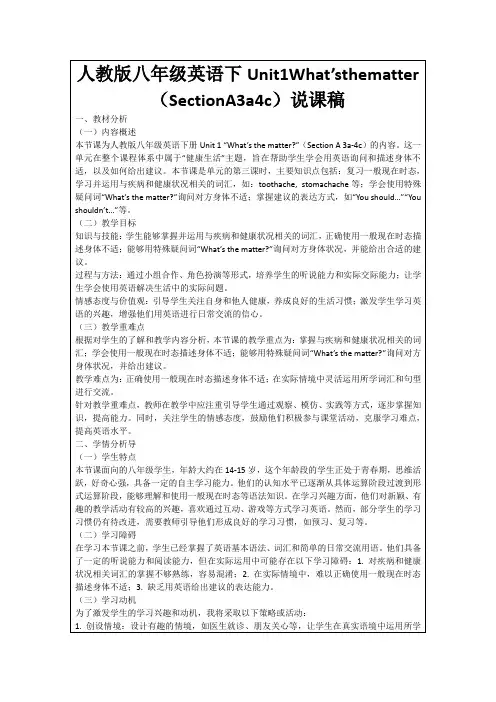
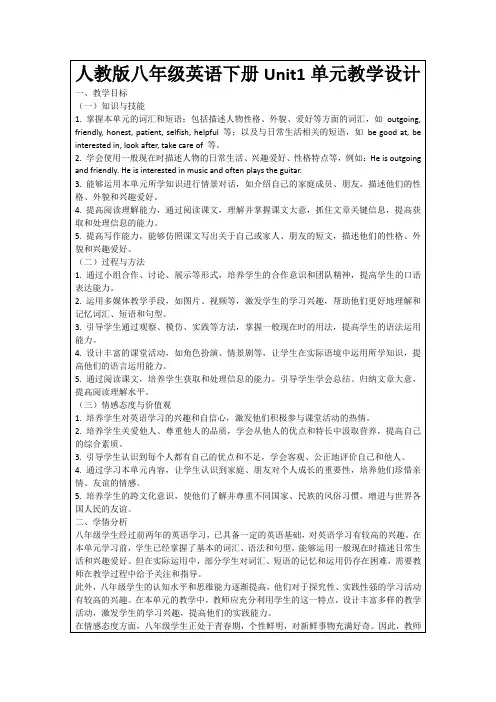
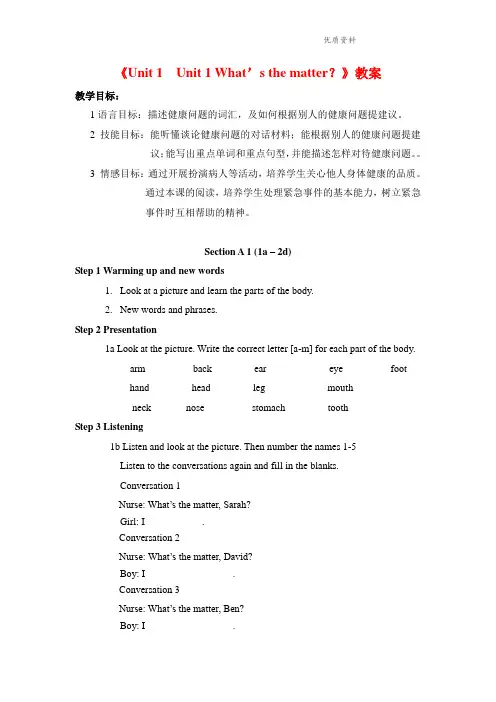
《Unit 1 Unit 1 What’s the matter?》教案教学目标:1语言目标:描述健康问题的词汇,及如何根据别人的健康问题提建议。
2 技能目标:能听懂谈论健康问题的对话材料;能根据别人的健康问题提建议;能写出重点单词和重点句型,并能描述怎样对待健康问题。
3 情感目标:通过开展扮演病人等活动,培养学生关心他人身体健康的品质。
通过本课的阅读,培养学生处理紧急事件的基本能力,树立紧急事件时互相帮助的精神。
Section A 1 (1a – 2d)Step 1 Warming up and new words1.Look at a picture and learn the parts of the body.2.New words and phrases.Step 2 Presentation1a Look at the picture. Write the correct letter [a-m] for each part of the body.___arm ___ back ___ ear ___ eye ___ foot___hand ___ head ___ leg ___ mouth___ neck ___nose ___ stomach ___ toothStep 3 Listening1b Listen and look at the picture. Then number the names 1-5Listen to the conversations again and fill in the blanks.Conversation 1Nurse: What’s the matter, Sarah?Girl: I ___________.Conversation 2Nurse: What’s the matter, David?Boy: I _________________.Conversation 3Nurse: What’s the matter, Ben?Boy: I _________________.Conversation 4Nurse: What’s the matter, Nancy?Girl: I _________________.Conversation 5Betty: What’s the matter, Judy?Ann: She __________________.Step 4 Speaking1c Look at the pictures. What are the students’ problems? Make conversati ons.ExamplesA: What’s the matter with Judy?B: She talked too much yesterday and didn’t drink enough water.She has a very sore throat now.A: What’s the matter with Sarah?B: She didn’t take care of herself on the weekend. She was p laying withher friends at the park yesterday. Then it got windy, but she didn’t puton her jacket. Now she has a cold.Step 5 Guessing gamesGuess what has happened to the students by using the important sentenc es. Step 6 Listening2a Listen and number the pictures [1-5] in the order you hear them.2b Listen again. Match the problems with the advice.Step 7 Speaking2c Make conversations using the information in 2a and 2bA: What’s the matter?B: My head feels very hot.A: Maybe you have a fever.B: What should I do?A: You should take your temperature.Step 8 Role–playImagine you are the school doctor. A few students have health problems.Role-play a conversation between the doctor and the students.2d Role –play the conversationStep 9 Language points and summary1. What’s the matter?这是人们特别是医生和护士询问病人病情时最常用的问句, 意思是“怎么了?”其后通常与介词with连用。
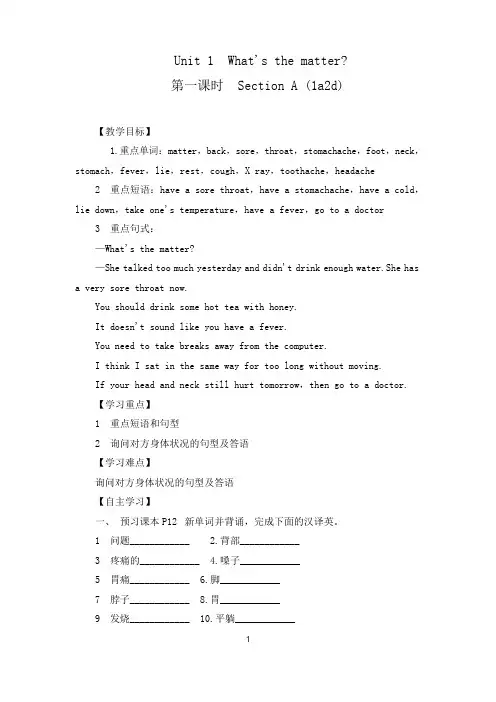
Unit1What's the matter?第一课时Section A(1a2d)【教学目标】1.重点单词:matter,back,sore,throat,stomachache,foot,neck,stomach,fever,lie,rest,cough,X ray,toothache,headache 2重点短语:have a sore throat,have a stomachache,have a cold,lie down,take one's temperature,have a fever,go to a doctor 3重点句式:—What's the matter?—She talked too much yesterday and didn't drink enough water.She has a very sore throat now.You should drink some hot tea with honey.It doesn't sound like you have a fever.You need to take breaks away from the computer.I think I sat in the same way for too long without moving.If your head and neck still hurt tomorrow,then go to a doctor.【学习重点】1重点短语和句型2询问对方身体状况的句型及答语【学习难点】询问对方身体状况的句型及答语【自主学习】一、预习课本P12新单词并背诵,完成下面的汉译英。
1问题____________ 2.背部____________3疼痛的____________ 4.嗓子____________5胃痛____________ 6.脚____________7脖子____________8.胃____________9发烧____________10.平躺____________11休息____________12.咳嗽____________13X光____________14.牙疼____________15头疼____________二、认真预习1a2d找出下列短语和句型。
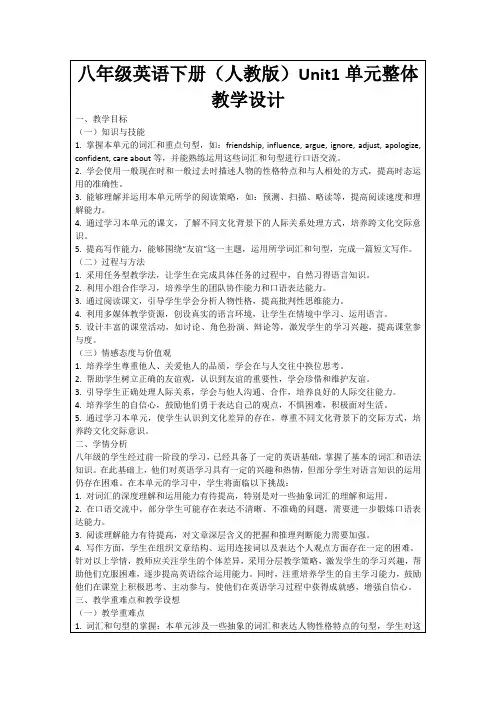
人教版八年级英语下册第一单元(同步教学设计)Unit 1 What’s the matter?Unit 1 What’s the matter?课时第1课时 Section A (1a~2d)课型新授课教学内容1. 身体部位的单词以及用have来表达健康问题。
2. 会用should对健康问题提出建议。
教学目标【知识与技能】1. 掌握句型:What’s the matter?I have a stomachache.You should lie down and rest.2. 掌握本课单词及短语: matter, stomachache, foot, neck, stomach, throat, fever, cough, Xray, toothache, headache【情感、态度与价值观】学会关心他人,养成良好的生活习惯,保持身体健康。
教学重点1. 学会表达健康问题的各种句型。
2. 能根据健康问题给出合理的建议。
教学难点讨论健康问题并给出相关建议。
教学准备视频,图片、多媒体等。
教学过程Step 1 Warmingup and lead in1. Greet as usual2. Play the song Head, Shoulders,Knees and Toes and let students sing together and review the vocabulary about the body parts.3. Look at the picture to review and learn some new word (throat, foot, knee, stomach)4. Game: I say you doEverybody moves your bodyNod your head and touch your faceTouch your nose and close your eyesTouch your ears and clap your handsRaise your arms and look at your backTouch your stomach and tap your footSit down and move your legs...Unit 1 What’s the matter?课时第2课时 Section A (3a~4c)课型新授课教学内容1.通过3a的短文练习阅读技巧2. 总结询问和回答疾病的句型及给出相关建议教学目标【知识与技能】1. 掌握句型:① What’s the matter with Ben?He hurt himself./ He has a sore back. He should lie down and havea rest.② What should she do?She should take her temperature.③ Should I put some medicine on it?Yes, you should. / No, you shouldn’t.2. 掌握本课单词及短语: hurt,passenger,off,get off,to one's surprise,ontotrouble【情感、态度与价值观】学生能关心自己和他人身体健康,助人为乐,能在英语交流中注意并理解他人的情感。
Unit1 What's the matter?1. KnowledgeWords: have, cold, back, arm, ear, eye, foot, hand, head, leg, mouth, neck, nose, tooth, fever, rest, should, headache, ago, so, illness, thirsty, early, problem, way, traditional, believe, weak, angry, medicine, western, everybody, get, few, stay, important, moment, late, until, yesterday, hearPhrases: have a cold, be stressed out, a few, at the moment Structures: Have for talking about health problems.Modal: should / shouldn 't2. SkillsTalk about your health.Give advice.3. Learning Strategies Using what you know. Inferring content.II. BackgroundIII. Teaching Time: Six PeriodsPeriod OneTeaching Aims:1. Learn and master the following words and phrases: matter, have, cold, have a cold, stomachache, sore, back, arm, ear, foot, hand, head, leg, mouth, neck, nose, stomach, tooth, throat2. Develop the students'listening ability.3. Be able to talk about health.4. Sentence PatternsWhat 's the matter? I have a sore throat.Teaching Difficult Point The sentence patterns.Teaching Methods Listening practice to train the students 'listening ability.PairwrokTeaching AidsSome pictures.A tape recorder. Teaching ProceduresStep I Greetings.Step II. 1aTeach the students to study the new words by showing some pictures.eye, nose, mouth, ear, tooth, face, head, neck, back, stomach, arm, hand, leg, footAsk a student to read the list of thirteen names of body parts.Then let the students look at the picture and write the correct letter for each part of the body. Check the answers. Answers:k arm c back g ear i eye m foot a hand l head b leg f mouth e tooth d neck j nose h stomach Step III 1bShow some illnesses.e.g. I have a cold. I have a stomachache. Let several students say some illnesses.Ask a student to read the names. Nancy, Sarah, David, Ben, JudyThen play the recording the first time. Students only listen. Play the recording a second time. Students number the names. Cheek the answersAnswers:Nancy = 3 Sarah = 1 David = 2 Ben = 5 Judy = 4Step IV 1cAsk two students to read the conversation.A: What 's the matter?B: I have a sore throat.Then let the students make conversations in pairs.After some minutes, ask several pairs to say their conversations.Explain the language points.1. What 's the matter? 你怎么啦?这句话在口语中很常见,当别人遇到什么麻烦,或身体不舒服,你就可以问What ' the matter?意思是你怎么啦?/ 你遇到什么麻烦啦?/ 你哪儿不舒服?还可以在句末用介词with 表示对象。
Unit 1 What’s the matter 教案目标确定的依据1.课程标准相关要求课程标准四级目标要求八年级学生能听懂熟悉话题的简单语段,能引出话题并进行交谈,能在教师的帮助下或根据简单的语音描述自己的经历。
2.教材分析本单元是改版后的八年级下册英语教材的第一个单元。
主要讨论的话题是询问某人的健康状况以及遇到麻烦的表达方法,本单元涉及到大量的表示人体部位的单词以及关于身体某部位不舒服的短语,并会根据不同的病情提出合理化的建议。
3.学情分析学生在小学阶段初步了解了一些人体部位的英文名称,但大部分学生仅能认识和听懂这些名称,不能准确发音和拼写。
本节课主要是对事故及事故伤害的询问及问答,并利用情态动词should提出建议。
目标1.识记本节课所学新单词的读音及拼写。
2.听录音,提取主要信息,学生初步运用下列句型进行对话What’s the matter with…?What should I/ you/ he/ she/they…do? I/ you/ he/ she/they should do…I/You/He/She/They have a headache/stomachache/fever.3.通过角色扮演,灵活应用所学词汇和句型进行简单的口语交际。
评价任务1.识记人体部位的英文名称。
2.运用What’s t he matter with…?I/You/He/She/They have aheadache/stomachache/fever. What should I/ you/ he/ she/they…do?等句型进行简单问答。
3.以角色扮演形式,对事故及事故伤害的询问及问答,并利用情态动词should提出建议。
教学过程:学习目标教学环节教学活动评价要点目标1:识记本节课所学新单词的读音及拼写(8分钟)环节一识记身体部位的英文名称活动1:看视频,图片识记身体部位的英文名称活动2:检测小组4号学生本节课所学新单词的拼写1.单词发音能否基本正确2.单词拼写能否全部掌握目标2:听录音,提取主要信息,学生初步运用下列句型进行对话(15分钟)What’s the matter with …?What should I/ you/ he/ she/they…do? 环节二听录音,取主要信息环节三模仿录音,两人运用句型谈论病情活动3:听录音,提取主要信息,完成听力练习。
Unit 1 What’s the matter?教材分析:本单元是改版后的八年级下册英语教材的第一个单元。
主要讨论的话题是询问某人的健康状况以及遇到麻烦的表达方法。
本单元涉及到大量的表示人体部分的单词以及关于身体某部位不舒服的短语。
此外,本单元还涉及到党当人身体不适时,医生、朋友或亲人提出的意见的表达法。
本单元共有阅读类文章两篇,文章的主体时态都为一般过去时。
主要句型为.What’s the matter with…?”“What should I/ you/ he/ she/they… do?”“I/ you/ he/she/they should do…?”“I have a headache/stomachache/toothache.” “Does she/he/ have a fever/cold/toothache…?”总的来说,本单元的相关语法知识并不难。
教学目标:1.知识目标:(1)掌握一些相关的词和词组:matter, sore, have a cold, foot, neck, stomach, throat, fever, lie, lie down, rest, cough, toothache, headache, break, hurt, passenger, get off, to one’s surprise, trouble, get into, climber, be used to, sick, risk, herself, sunburned等;(2)掌握反身代词的用法;enjoy oneself, help oneself to,(3)掌握情态动词should的用法;(4)掌握以下主要句型:. What’s the matter with…?”“What should I/ you/ he/ she/they… do?”“I/ you/ he/ she/they should do…”“I have a headache/stomachache/toothache.”“Does she/he/ have a fever/cold/toothache…?”2.能力目标:1.能够用英语询问某人的身体状况以及关心他人是否遇到麻烦;2.提高学生合作学习、自主学习的能力。
3.并能熟练运用所学知识就过去活动进行描述,学生听说读写的能力得到提高。
4.会使用部分情态动词;情感目标: 1.教会学生关心他人,培养同学间团结、友善的精神。
2.通过本单元的学习能引导学生关注自己及身边人的身体健康、并学习如何去关心他人及提出适当的建议。
3.能使学生意识到要如何去保持健康并养成良好的生活习惯。
4.培养学生主动救助处于危险境地的人的精神,在紧急关头,有勇气做出正确的决定。
此外,生活中遇到困境,需要有坚强的意志力去面对一切。
教学难点:掌握情态动词should \shouldn’t. 的用法学习have的用法课时划分:Section A1 1a – 2dSection A2 3a-3cSection A3 Grammar Focus-4cSection B1 1a-2eSection B2 3a-Self checkSection A 1 (1a – 2d)Step 1 Warming up and new words1.Look at a picture and learn the parts of the body.2.New words and phrases.Step 2 Presentation1a Look at the picture. Write the correct letter [a-m] for each part of the body.___arm ___ back ___ ear ___ eye ___ foot___hand ___ head ___ leg ___ mouth___ neck ___nose ___ stomach ___ toothStep 3 Listening1b Listen and look at the picture. Then number the names 1-5Listen to the conversations again and fill in the blanks.Conversation 1Nurse: What’s the matter, Sarah?Girl: I ___________.Conversation 2Nurse: What’s the matter, David?Boy: I _________________.Conversation 3Nurse: What’s the matter, Ben?Boy: I _________________.Conversation 4Nurse: What’s the matter, Nancy?Girl: I _________________.Conversation 5Betty: What’s the matter, Judy?Ann: She __________________.Step 4 Speaking1c Look at the pictures. What are the students’ problems? Make conversations.ExamplesA: What’s the matter with Judy?B: She talked too much yesterday and didn’t drink enough water.She has a very sore throat now.A: What’s the matter with Sarah?B: She didn’t take care of herself on the weekend. She was playing with herfriends at the park yesterday. Then it got windy, but she didn’t put on her jacket.Now she has a cold.Step 5 Guessing gamesGuess what has happened to the students by using the important sentences.Step 6 Listening2a Listen and number the pictures [1-5] in the order you hear them.2b Listen again. Match the problems with the advice.Step 7 Speaking2c Make conversations using the information in 2a and 2bA: What’s the matter?B: My head feels very hot.A: Maybe you have a fever.B: What should I do?A: You should take your temperature.Step 8 Role–playImagine you are the school doctor. A few students have health problems. Role-play a conversation between the doctor and the students.2d Role –play the conversationStep 9 Language points and summary1. What’s the matter?这是人们特别是医生和护士询问病人病情时最常用的问句, 意思是“怎么了?”其后通常与介词with连用。
类似的问句还有:What’s wrong? 怎么啦?What’s wrong with you? 你怎么了?What’s your trouble? 你怎么了?What’s the trouble with you? 你怎么了?What’s up? 你怎么了?2. have a cold伤风, 感冒, 是固定词组表示身体不适的常用词组还有:have a bad cold 重感冒have a fever 发烧have a headache 头痛have a stomachache 肚子痛, 胃痛have a toothache 牙痛Summary1. 牙疼have a toothache2. 胃疼have a stomachache3. 背疼have a backache4. 头疼have a headache5. 喉咙疼have a sore throat6. 发烧have a fever7. 感冒have a cold8. 躺下并且休息lie down and rest9. 喝热蜂蜜茶drink hot tea with honey10. 喝大量水drink lots of water11. 看牙医see a dentist12. 量体温take one’s temperature13. 看医生go to a doctorStep 10 Exercises根据上下文意思填空。
Mandy: Lisa, are you OK?Lisa: I _____ a headache and I can’t move my neck. What ______ I do? Should I _____ my temperature?Mandy: No, it doesn’t sound like you have a fever. What _____ you do on theweekend?Lisa: I played computer _____ all weekend.Mandy: That’s probably why. You need to take breaks _____ from the computer.Lisa: Yeah, I think I sat in the _____ way for too long without moving.Mandy: I think you should ____ down and rest. If your head and neck still hurt tomorrow, then go to a _______.Lisa: OK. Thanks, Mandy.翻译下列句子。